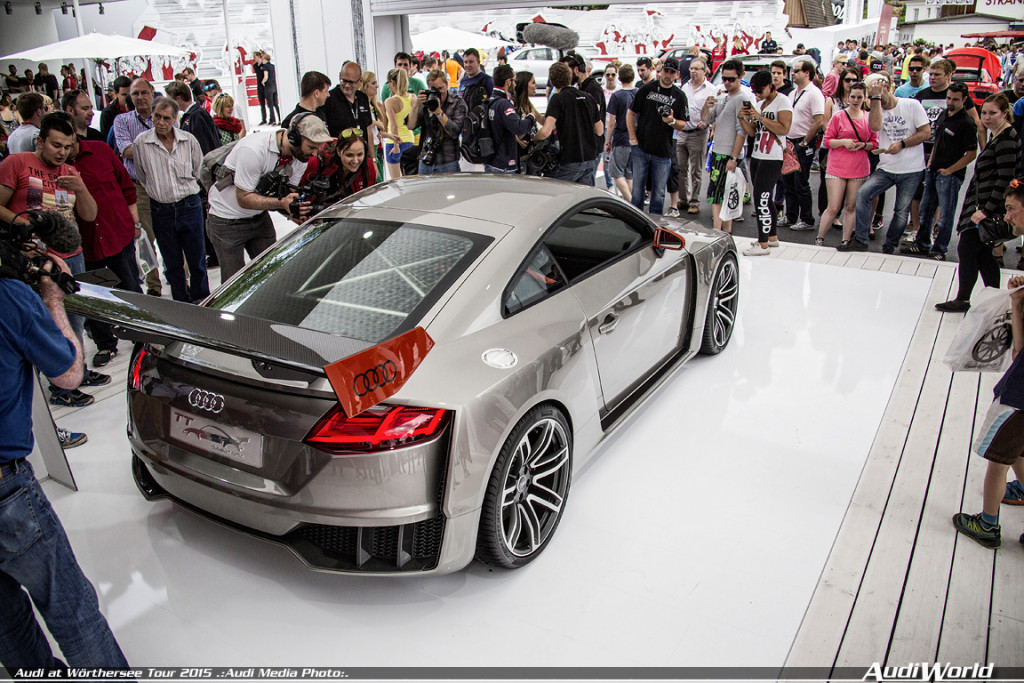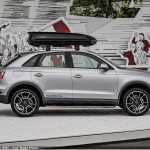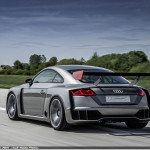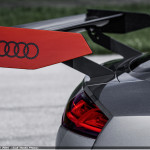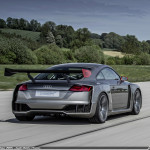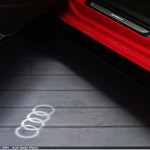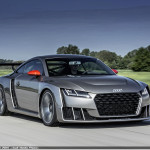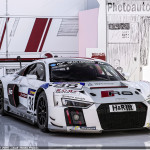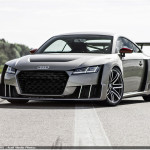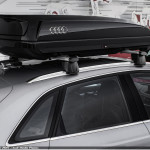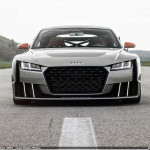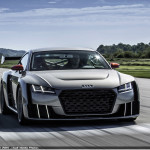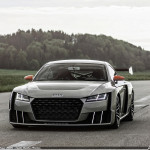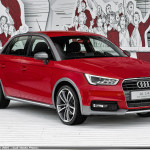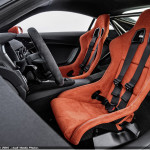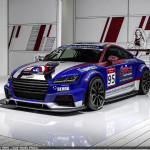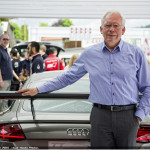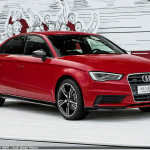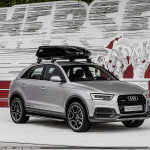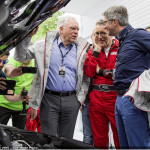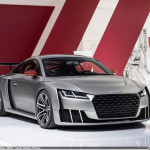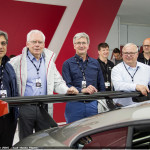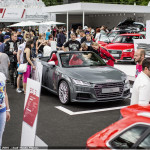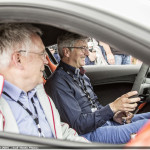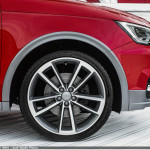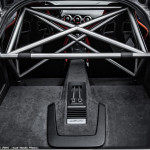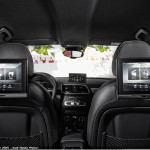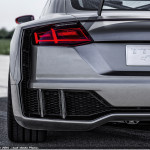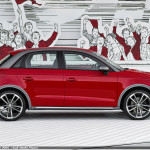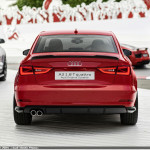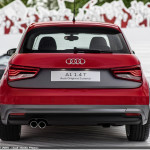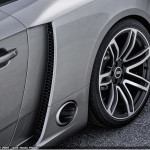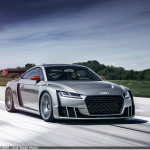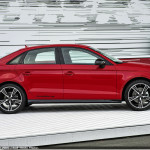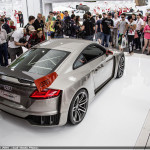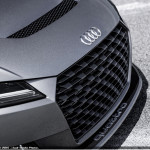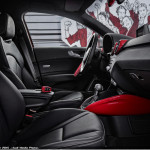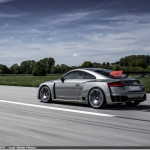Audi at Wörthersee Tour 2015
- Audi TT clubsport turbo concept combines a 2.5 TFSI with an electric biturbo for the first time
- Board Member for Development, Prof. Dr. Ulrich Hackenberg: “Technology close to production readiness”
- Current race cars and production models covering 1,500 square meters (16,145.9 sq ft)
Wide add-on parts, a powerful rear wing and a power output of 441 kW (600 hp) – the Audi TT clubsport turbo impresses with its power and design. The inspiration for the show car came from the successful Audi 90 IMSA GTO of the late 1980s.
“The electric biturbo signifies a new dimension in driving enjoyment; it boosts sprinting ability and torque and enables high peak power,” explains Prof. Dr. Ulrich Hackenberg, Audi Board Member for Technical Development. “In our TDI engines, we are close to production readiness with this technology. We are now presenting it in a TFSI – here too, we are the first automaker in the world to do this. For our fans at Wörthersee, we have packaged the electric biturbo in a very sporty show car.”
The Audi TT clubsport turbo has a power-boosted 2.5 TFSI engine with very impressive performance data. From 2,480 cc of displacement, the five-cylinder engine produces 441 kW (600 hp) of power and 650 Nm (479.4 lb-ft) of torque. More than 600 Nm of torque are available between 3,000 and 7,000 rpm. This means that it produces 176 kW (240 hp) and 260 Nm (191.8 lb-ft) per liter of displacement. Power is transferred via a manual six-speed transmission.
Thanks to systematic lightweight design, the TT clubsport turbo show car has an unladen weight of just 1,396 kg (3,077.7 lb). The car completes the standard sprint from 0 to 100 km/h (62.1 mph) in 3.6 seconds, and its top speed is 310 km/h (192.6 mph). The TT clubsport turbo plays out its big advantage over the first few meters of a sprint. Its electrically driven compressor lets it cover up to 16 meters (52.5 ft) within the first 2.5 seconds – which is six meters (19.7 ft) further than a comparable car without this innovation. That is a difference of around one and a half car lengths.
Electric thrust: additional compressor assists the turbocharger at lower revs
The big advantage of an electrically powered compressor: It revs up to maximum rpm rapidly and without any perceptible delay, and it continues to boost charge pressure when too little drive energy is left in the exhaust gas for the conventional turbocharger. This operating principle makes it possible to design the conventional turbocharger more specifically for high charge pressures and consequently for high engine power – the eTurbo consistently assures spontaneous response and powerful sprints from low engine speeds.
The effect is impressive. The 2.5 TFSI engine builds up its tremendous power without any perceptible delay. This power is available in any situation – whenever the accelerator pedal is pressed. In an acceleration duel, the TT clubsport turbo effortlessly pulls away from a counterpart with an equally powerful engine but no electric biturbo.
Power storage: the 48-volt electrical system
However, it is not just the power of the five-cylinder engine that is fascinating – so is its unmistakable throaty sound. The exhaust system is designed for minimal back-pressure; a side pipe to the ambient air is located immediately after the racing-type muffler. The 2.5 TFSI engine is cooled by a racing-type radiator. In the lower engine speed range, the electrically driven compressor boosts torque by up to 130 Nm (95.9 lb-ft). A dedicated 48‑volt electrical sub-system – another key future technology from Audi – supplies electrical energy to the turbocharger. A compact lithium-ion battery in the luggage compartment stores the energy generated by recuperation when coasting. A DC/DC converter provides the connection to the 12-volt electrical system.
The power of the Audi TT clubsport turbo reaches the road impressively via a quattro permanent all-wheel drive system with its multi-plate clutch mounted on the rear axle for better weight distribution. A coilover suspension system enables highly precise adjustment of the body’s ride height and the compression and rebound of the shock absorbers. An electric lifting function protects the equipment from damage by street curbs. Electronic stabilization control (ESC) and torque vectoring perfectly round out the dynamic qualities of the suspension.
The show car’s wheels are size 9.5 J x 20. Their six twin-spoke design is finished in a two-color look – both in gloss turned finish and matt black – and the tires are size 275/30. Carbon-fiber ceramic brake disks are mounted behind all four wheels; they are very lightweight and wear-resistant. The front brake disks measure 370 mm (14.6 in) in diameter.
Another 14 centimeters wide: spectacular add-on parts
The compact sports car takes a full stance on the road with track widths of 1,736 mm (5.70 ft) in front and 1,729 mm (5.67 ft) at the rear. The car is 4.33 meters (14.2 ft) long and 1.97 meters (6.5 ft) wide, including the side mirrors – 14 cm (5.5 in) wider than the technical platform upon which it was based. Its angular fenders contribute their own, built-up shape to the car body. They take the characteristic design motif of the Audi TT to an extreme and accentuate the distribution of engine power to all four wheels – the quattro drive. The fenders of the show car – painted in the exterior color Ferro Titanium – are open at the front and rear. Air from the car’s slipstream flows through them to cool the brakes. The Singleframe grille and large air inlets – whose vertical fins continue the signature theme of the Matrix LED headlights – are also optimized for maximum air throughput.
The manually adjustable rear wing is an advanced development of the Audi Sport TT Cup, with which the brand very recently launched a dedicated race series. It is now 20 cm (7.9 in) wider, and the side flaps, which feature the four rings, were given a new geometry. The wing consists of carbon fiber-reinforced polymer (CFRP) as do all other add-on parts: the air inlets and the large splitter at the front, the side panels and side sill trims as well as the voluminous diffuser at the rear whose lateral segments reference the motif of the air inlets.
The interior: completely focused on the sporty driver
A protective “cage” of ultra-high-strength titanium tubes makes the rear zone of the interior even more rigid and safe. In front, there are lightweight racing bucket seats with four-point harnesses. The display and operating concept with the digital Audi virtual cockpit focuses on the driver, who can control all key driving parameters by using the four satellite buttons on the multifunction steering wheel.
Sporty materials such as CFRP and black Alcantara define the interior of the Audi TT clubsport turbo. The racing bucket seats are upholstered in coral orange Alcantara and feature contrasting stitching and piping. CFRP parts with their large surfaces create sporty accents on the doors and center console, and the doors are closed by pulling on a tube-shaped grip with an Alcantara inlay. The air vents and gear shift also have coral orange accents – the aluminum gear shift lever travels in an open shift gate.
This year’s motto is “Audi Sport,” and the Audi stand has been transformed into the Audi Pit Lane. In keeping with this theme, two race cars are displayed in an area of around 1,500 square meters (16,145.9 sq ft), along with the A3 clubsport quattro concept and nine production models, including some with attractive Audi Genuine Accessories.
The motorsport experience: the race cars at Wörthersee
The new Audi R8 LMS has some big shoes to fill – after all, its predecessor won a total of 26 GT3 championships between 2009 and 2014 as well as 23 titles in other competitions and seven overall victories in 24-hour races. The second generation far exceeds the safety standards of the regulations taking effect in 2016. As a result, the modified front carriage structure of the GT3 sports car and a crash element in the car’s rear, made for the first time from carbon-fiber-reinforced polymer (CFRP), fulfill the crash test requirements that apply to much lighter Le Mans prototypes (LMP) like the Audi R18 e-tron quattro. For the first time in a GT3 racing car there is a rescue hatch in the roof like those found in DTM race cars: these allow the driver’s helmet to be removed from above after an accident in order to protect the spine.
Audi consistently demonstrates its expertise in lightweight construction in the new R8 LMS: The intelligent combination of aluminum in the Audi Space Frame (ASF), a CFRP structural component and the steel roll cage makes the chassis alone around 30 kilograms (66.1 lb) lighter – it now weighs just 252 kilograms (555.6 lb). At the same time, the torsional strength of the supporting frame has increased by 39 percent.
With the R8 LMS, Audi has focused on production parts in racing precisely where they make the most sense technically and in terms of cost-efficiency. Example: The V10 engine with 5.2 liters of displacement and power output of up to 430 kW (585 hp) comes from the same assembly line as the production engine. It remains virtually unchanged and with a planned rebuild interval of 20,000 kilometers (12,427.4 mi), it sets a new standard in racing.
Design engineers use modified or completely new components in racing only when they are required by regulations or if they are needed due to significantly greater loads during competition. For instance, the production ASF chassis is being adapted, while the completely new body is made of CFRP. For the first time, pure racing transverse links are being installed in the wheel suspension. The six-speed transmission with paddle shift is an entirely new development. It is significantly lighter than its predecessor and its efficiency has also increased thanks to the elimination of the previous drop gear system.
The Audi TT cup also has its own trial by fire behind it: After successfully launching the season in early May with the newly created brand competition Audi Sport TT Cup at the Hockenheimring, the premium brand is now also presenting the race cars at Wörthersee.
The extremely light body of the third-generation TT, with its sophisticated combination of steel and aluminum, offers an ideal basis for a racing car. The four-cylinder TFSI and the six-speed S tronic have also been adopted from the production model with practically no modifications. An active differential that can be adjusted electronically in the cockpit offers optimal traction on the front axle.
The racing version of the new Audi TT has 228 kW (310 hp) of power output with a weight of just 1,125 kilograms (2,480.2 lb). The output of the two-liter TFSI engine can be boosted for brief periods by 22 kW (30 hp) using the “push-to-pass” function. The race cars are all built and maintained at quattro GmbH. This is the company’s way of ensuring as much fairness as possible in the starting field of 24 racers.
After the successful premier in Hockenheim, the Audi Sport TT Cup will pay a visit to the Norisring during the last weekend in June. The third and fourth of a total twelve races will take place there.
New in series production: the Audi models
Like its racing counterpart, the series production model Audi TTS Roadster is built around a 2.0 TFSI engine. The sprint from 0 to 100 km/h (62.1 mph) takes just 4.9 seconds. With quattro permanent all-wheel drive, Audi has completed a major phase of development. Its electrohydraulic multi-plate clutch optimally distributes the drive torque between the front and rear axle depending on driving conditions, road characteristics and driver type. For the first time at Audi, the quattro clutch in the TTS is integrated into Audi drive select system.
The Audi virtual cockpit celebrated its debut in the new TT generation in early 2014. The digital instrument cluster with its 12.3-inch TFT monitor presents all information in pin-sharp and high-contrast 3D graphics and offers the driver various views to choose from. A third mode centered around the rev counter – perfect for driving on a race track – is added in S models.
This is precisely what moves the new Audi R8* to the front of the pack. No model with the four rings is closer to motorsport and none is faster: In the top version, a V10 mid-engine with 449 kW (610 hp) catapults the high-performance sports car from 0 to 100 km/h (62.1 mph) in just 3.2 seconds; its top speed is 330 km/h (205.1 mph). The combination of aluminum and carbon fiber-reinforced plastics (CFRP) in the Audi Space Frame opens up new dimensions with regard to weight, rigidity and crash behavior. The aerodynamic underbody, which integrates a long diffuser, boosts downforce. With its double wishbone suspension, the chassis, too, demonstrates how close the new Audi R8 is to motorsport.
The design reflects the powerful sporty character of the R8. A visual distinguishing feature which also provides enhanced safety comes in the form of the standard LED headlights. For an extended field of vision and more brightness, Audi offers the laser spot for the high beam as an option. In the interior, the indicators are of course digital. The most important controls for the Audi virtual cockpit are grouped together in button clusters on the steering wheel called “satellites.” As a result, drivers feel like they are sitting in a race car.
A different class of car but with the same standards: With the new Q7*, Audi is also setting standards in the premium SUV segment. The reduction in weight of up to 325 kilograms (716.5 lb) and the low center of gravity make it extremely agile. At the same time, it is the most spacious car in its segment. Although the exterior dimensions have gotten smaller, it offers substantially more interior room for passengers and luggage. Its innovative assistance and infotainment systems take the SUV to the front of the pack. New features include the 3D sound and smartphone integration of Google Android Auto and Apple Carplay.
The engines produce top values in the segment of large SUVs with all-wheel drive. The 3.0 TDI with 200 kW (272 hp) and the 3.0 TFSI with 245 kW (333 hp) accelerate the new Audi Q7 from 0 to 100 km/h (62.1 mph) in 6.1 seconds (TFSI) and 6.3 seconds (TDI), respectively. The diesel V6 consumes on average just 5.7 liters of fuel per 100 km (41.3 US mpg), corresponding to 149 grams of CO2 per km (239.8 g/mi).
Pure performance: the latest RS models
Also among the cars at Wörthersee are the RS models that represent the dynamic spearhead of each model series. Built under the auspices of quattro GmbH, a wholly owned subsidiary of AUDI AG, the RS models feature the most powerful engines, quattro permanent all-wheel drive, extreme driving dynamics, and full everyday utility.
One of the cars Audi is presenting at Wörthersee is the strongest car in the compact class: The new RS 3 Sportback* comes with the multiple award-winning 2.5 TFSI that features 270 kW (367 hp) and 465 Nm (343.0 lb-ft) of torque. The turbocharged engine accelerates the compact five-door from 0 to 100 km/h (62.1 mph) in 4.3 seconds, and top speed can be increased to 280 km/h (174.0 mph) upon request. In the NEDC, it consumes just 8.1 liters of fuel per 100 km (29.0 US mpg), with CO2 emissions of 189 grams per kilometer (304.2 g/mi).
The chassis of the five-door model also sets standards. Compared with the Audi A3 Sportback, the body is 25 millimeters (1.0 in) lower. The pivot bearings of the front axle, the progressive steering, the RS-specific sport suspension and optional Audi magnetic ride adaptive damper control are designed specifically for the RS. If requested, Audi mounts carbon fiber-ceramic brake discs behind the 19-inch wheels on the front axle – a first in the premium compact segment.
Like the Audi A3 Sportback, the RS Q3* also relies on a 2.5 TFSI: The five-cylinder engine accelerates the compact performance SUV from 0 to 100 km/h (62.1 mph) in just 4.8 seconds; the top speed is 250 km/h (155.3 mph) (governed). Average fuel consumption is 8.4 liters per 100 kilometers (28.0 US mpg), corresponding to 198 g CO2 per km (318.7 g/mi). An RS exhaust system with a switchable flap adds even more volume to the unmistakable sound of the five-cylinder engine.
The product improvements make the Audi RS Q3 even more distinctive and sharp. The Singleframe grille – with a matt aluminum-look frame and high-gloss black honeycomb grille – has been redesigned, and a quattro logo adorns the air intake in the front bumper. The aluminum roof rails, long RS roof spoiler, updated LED taillights and xenon headlights, the modified rear bumper and the long, elliptical exhaust tailpipe complete the dynamic look.
The new Audi RS 6 Avant* impresses with immense power. Its 4.0 TFSI has an output of 412 kW (560 hp) and makes 700 Nm (516.3 lb-ft) of torque available between 1,750 and 5,500 rpm. The top model in the A6 family sprints like a supercar from 0 to 100 km/h (62.1 mph) in 3.9 seconds and with the optional dynamic package reaches a top speed of 305 km/h (189.5 mph). In the combined cycle, however, the V8 biturbo consumes just 9.6 liters of fuel per 100 kilometers (24.5 US mpg), corresponding to 223 grams CO2 per kilometer (358.9 g/mi).
The COD (cylinder on demand) cylinder management system and the active engine bearings are also on board the refreshed RS 6 Avant. The two twin-scroll turbochargers are positioned inside the 90-degree V. This solution ensures that considerable torque is generated quickly. A sportily tuned, eight-speed tiptronic transfers the engine torque to the quattro permanent all-wheel drive, which uses a center differential with a high locking rate. The sport differential for the rear axle is available either as a single item or as part of the dynamic package.
Close attention to detail: Audi Genuine Accessories
Audi Genuine Accessories allows customers to personalize their car – matching it to their own needs and personal taste. The portfolio ranges from practical solutions like roof boxes or bicycle racks to unusual details like a light projection when opening the car door.
The premium car brand offers the new active kit for the Audi A1 and Audi A1 Sportback, for instance. Its sporty urban character is highlighted by the front spoiler, rear apron, wheel arch trims and side sills in platinum gray, with aluminum-look applications rounding off the exterior design. The range of wheels, too, is matched to the active kit; the five-arm Cavo design wheels are available in 17 and 18-inch diameter.
With the active kit decals, the contrasting roof line and the lower rear section in platinum gray stand out from the basic car color. The exterior mirror housings in the same color complete the distinctive appearance. The active kit for the Audi A1 and Audi A1 Sportback is either fitted at the time the car is delivered or can be retrofitted by the Audi dealer.
The style package for the A3 family includes attention-grabbing features. These start with side sills, rear diffuser and rear apron – all available in brilliant black, or by request, in the color of the car. Added to this are a roof edge spoiler and exterior mirrors made from carbon. Another product from Audi Genuine Accessories shows distinctive style even as you enter the car. With this eye-catching feature, the quattro logo is projected on the ground by LEDs when the door is opened.
This product enhancement for the Audi Q3 has been available in dealerships since February. The three TFSI and three TDI clean diesel four-cylinder engines boast higher output combined with reduced fuel consumption: CO2 emissions have been reduced by 17 percent. The engines have 1.4 or 2.0 liters of displacement and power output of between 88 kW (120 hp) and 162 kW (220 hp).
Audi Genuine Accessories offers the offroad style package to further emphasize the athletic nature of the compact SUV. Selective accents give the Q3 an even more robust and sporty look. These include exterior features like bumpers, wheel arch and door trim strips in metallic stone gray. In addition, the quattro logo is displayed on both sides of the rear of the vehicle. Pedal caps and side running boards are made from stainless steel. The running boards have a maximum load of 200 kilograms (440.9 lb) and make it easier to load items in the ski and luggage box on the roof. These are lockable and can be opened from both sides, which also offers added convenience. In glistening brilliant black, with side blades and chrome Audi rings, it is a striking visual highlight.
Audi Entertainment mobile is yet another new product offering. The 10-inch touch screen can be fitted in the Audi Q3 with preparation for Rear Seat Entertainment on the backrests of the front seats or used outside the vehicle. It offers a convenient display for videos, photos, games and music – with intuitive software controls and includes a wide range of connection options (SD, USB 2.0, HDMI-IN, etc.). Audi Entertainment mobile will be available from Audi Genuine Accessories starting in summer.

